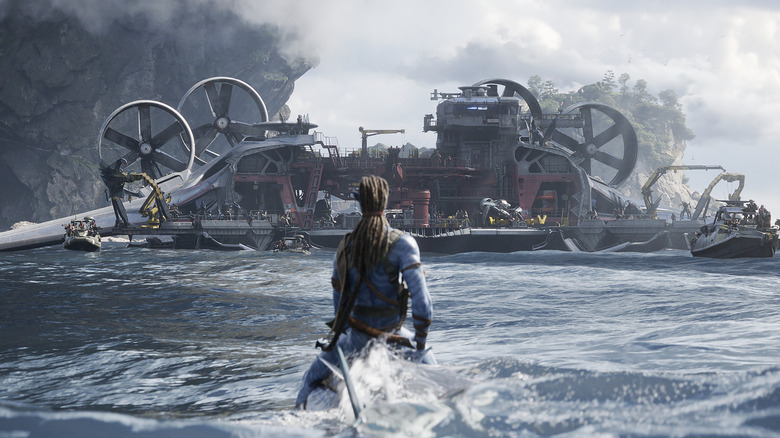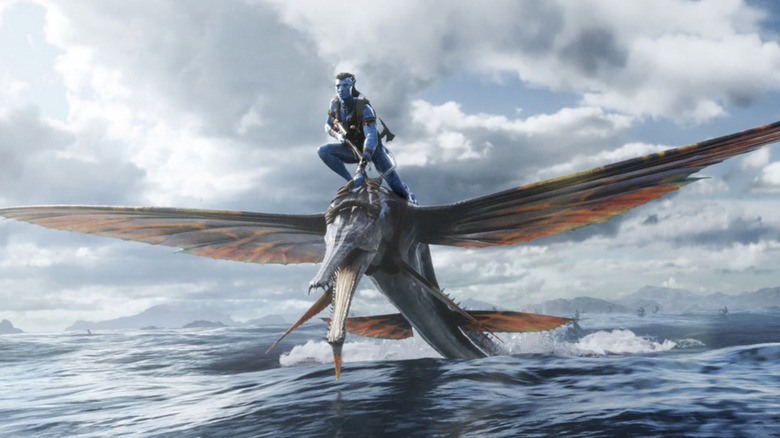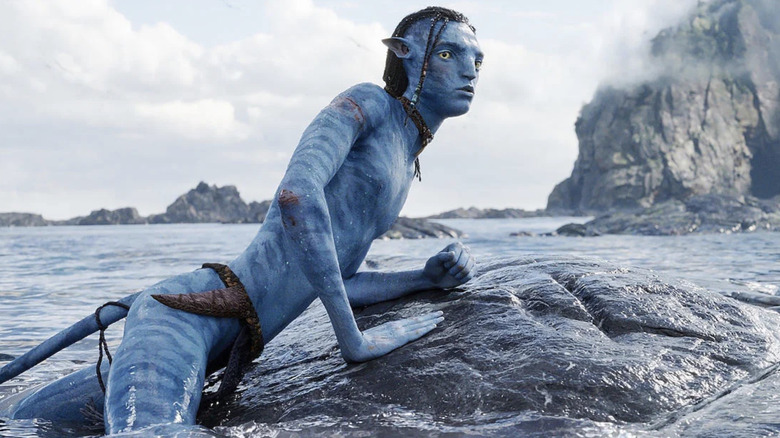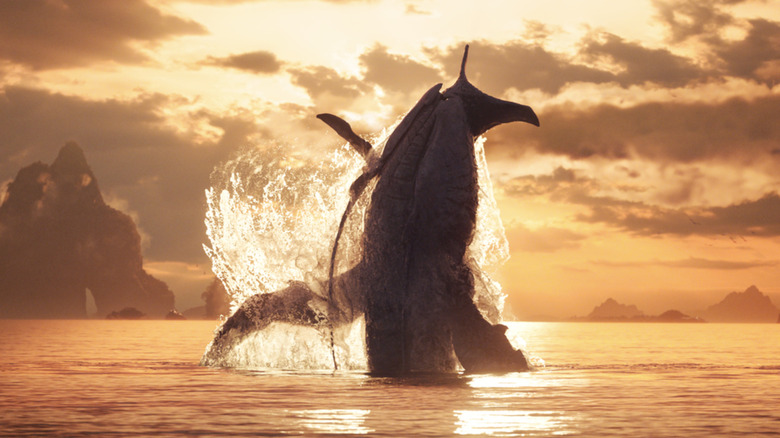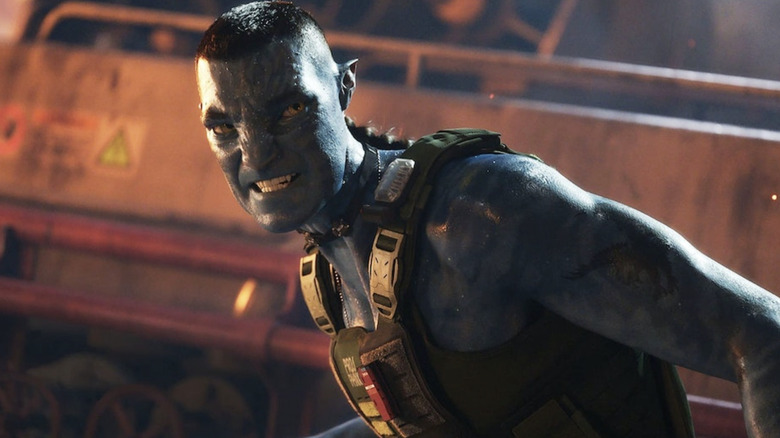Avatar: The Way Of Water Is Further Proof That No One Does Action Better Than James Cameron
This post contains spoilers for "Avatar: The Way of Water."
James Cameron's newest film, "Avatar: The Way of Water," is finally in theaters after a 13-year wait between movies. The sequel to the original "Avatar" movie is not only a breathtaking visual upgrade that explores the depths of the ocean of Pandora; it's also a more thematically resonant film than the first, with exceptional character work that builds up to an exciting and climactic conclusion.
That brings us to the film's action, which is truly incredible in the shorter bursts we get in the first two hours of its lengthy three-hour runtime. That duration is absolutely justified, as Cameron goes on to execute some of the best action set pieces in years with the explosive third act.
Although the stakes aren't as large as the original "Avatar" film, the setting, characters involved, and pacing of the third act make the action feel more tense by getting the audience invested in its outcomes. "The Way of Water" is a much more personal and intimate affair. The final hour feels like it has its own three-act structure that it adheres to, taking audiences on an emotional rollercoaster with stunning choreography that pairs with the emotional beats of the movie all too well. James Cameron also showcases that he can do more than one kind of action set-piece; even the space whales have impressive combat skills.
Variety is the name of the game
A lot of the action in "Avatar: The Way of Water" happens to take place on a boat, as Jake's children are held hostage by a newly-resurrected Colonel Quaritch in a Na'vi body. Here, the action is on a whole other level compared to the other recent water-centric blockbuster, "Black Panther: Wakanda Forever." The hostage situation begins a drawn-out and intense battle between the RDA and the Metkayina clan, with Jake Sully leading the charge.
It's not as grand a battle as the gathering of multiple Na'vi clans for a standoff between the entire might of the RDA in the first "Avatar" movie. But while the numbers are smaller this time around, that allows Cameron to expertly stage his action on multiple fronts without losing focus on the story. The geography of the reef where the big final battle takes place allows the action to take place on boats, in the sea, and even in the air. Variety is the name of the game for Cameron, and the choreography for all of these fights never feels repetitive. There's also diversity in the participants, from the humans controlling fascinating crab-like robots to the Avatar marines, and even a space whale; there are plenty of threats to keep things interesting.
At the heart of this battle are the Sully family, and their strength as a unit carries the action giving it all the emotional heft it needs. Cameron is a master of incredible fight choreography, giving meaning to the fights and letting audiences worry and care about those involved. It also helps that Cameron plays around with genre when framing the action.
Playing with different genres
While the core of "Avatar: The Way of Water" is Cameron's well-documented love of the ocean, it also plays with the more frightening aspects of underwater sequences to create a real sense of dread for Jake and Neytiri's children, who are desperately trying to escape the RDA at the beginning of the big battle. There are moments where the sky people's mechanical monstrosities nearly consume the younger members of the Sully family, who are also up against the ticking clock of how long they can go without breathing, and Cameron utilizes that tension to near perfection. Jump scares strewn through the underwater chase sequences effectively convey the terror of being hunted. While the cycle of Sully children being tied up, freed, and getting tied up again can get a bit repetitive, the constant rotation of a small cast of fighters lets Cameron keep a good pace in all the Pandora chaos.
Though the focus is primarily on the Sully family, the culture and the Metkayina's relationship with the aquatic life of Pandora play a pivotal role in both the action and the spiritualism at the heart of the movie. James Cameron uses the marine life he created for Pandora for more than just some stunning "Planet Earth"-esque cinematography; he turns a space whale into a full-on action hero.
Unexpected space whale action
If you expected Cameron to save all the best staging and choreography for the fight between Jake and Quaritch, you'd be wrong. That honor goes to Payakan; a Tulkun cast out from his species and from the Metkayina because of his willingness to fight back against the Sky People. Payakan bonds with Jake Sully's second oldest son Lo'ak, who also feels like an outcast and a disappointment to his father throughout the film. After Jake's children (Lo'ak included) are taken hostage in the process of saving Payakan's life, the Tulkun intervenes and shows the Tulkun hunters what's what. The space whale's considerable mass doesn't stop Cameron from creating unique scenarios for the creature to play its highly entertaining role in the fight, and the action also weaves into the themes and character relationships in the movie.
James Cameron understands how to give genuinely nasty characters their comeuppance — especially Captain Mick Scoresby (Brendan Cowell), the head of the marine hunting vessel, who is seen gleefully hunting down and killing a female Tulkun and her calf in the middle act of "The Way of Water." Payakan, who once lost a fin to Scoresby (along with his soulmate and many other Tulkun, gets some poetic justice by using the captain's own boat to remove his arm, in a great crowd-pleasing moment.
But while unexpected supporting characters get their time to shine, Cameron doesn't forget about main characters like Jake and Quaritch, whose battle constantly moves locations and leaves viewers on the edge of their seats. Although the film's third act is one extended action sequence, it never loses its flair because it constantly changes up the scale and pace.
The final confrontation
The Sully family and Quaritch's final confrontation in "The Way of Water" exemplifies everything that makes Cameron a great action director. Their battle starts with their respective Pandora creatures duking it out in a war of sea versus air and, later on, within the sinking RDA vessel. There's a careful balance of tone, going from the bombastic first half of the battle to the much more intense and deeply emotional second half, which is restrained in its scale yet more brutal than anything else in the film. Cameron paints fighting in all sorts of different emotions in "The Way of Water," but none is more potent than the lens of grief with Neytiri. Her rampage toward the end of it all is her way of grieving a tremendous loss, but seeing her wrath from Spider's point of view is a reminder of just how formidable and frightening the Na'vi are from a human perspective.
Action set pieces can often feel rote and unimaginative, but "Avatar: The Way of Water" has some of the most incredible action sequences I've seen in years. If the rest of the "Avatar" sequels have moments as stunning, diverse, captivating, and thematically resonant as what's seen in "The Way of Water," the saga shouldn't have any trouble bringing audiences back for more.
